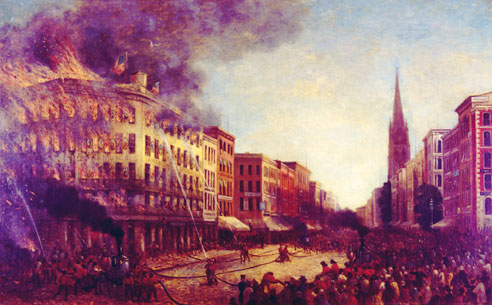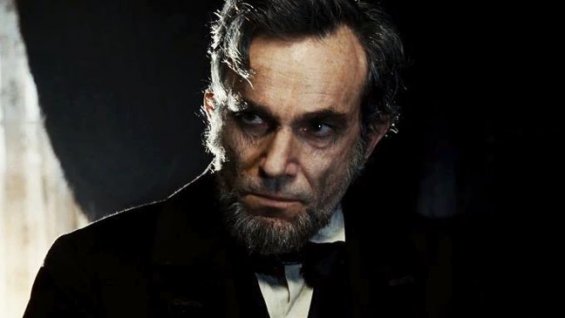 According to the “Lincoln” movie script, Friday, January 27, 1865 was an action-packed and pivotal day. It was the day of Thaddeus Stevens’s controlled performance in the House, declaring himself strictly for “equality before the law.” It was also the day marked by Abraham Lincoln’s bitter argument with his oldest son Robert and then his subsequent clash with his wife Mary after he finally decided to concede to Robert’s desire to join the Union army. And it was in the evening of the 27th that both Mary Lincoln and later dressmaker Elizabeth Keckley urged the president to abandon his hidden-hand approach and provide more decisive leadership in the fight for the antislavery amendment. All of those “events” are fictional, but they are essential for understanding the film’s point-of-view –namely, that Lincoln interjected himself at the end of the battle for the constitutional amendment in a way that proved decisive.
According to the “Lincoln” movie script, Friday, January 27, 1865 was an action-packed and pivotal day. It was the day of Thaddeus Stevens’s controlled performance in the House, declaring himself strictly for “equality before the law.” It was also the day marked by Abraham Lincoln’s bitter argument with his oldest son Robert and then his subsequent clash with his wife Mary after he finally decided to concede to Robert’s desire to join the Union army. And it was in the evening of the 27th that both Mary Lincoln and later dressmaker Elizabeth Keckley urged the president to abandon his hidden-hand approach and provide more decisive leadership in the fight for the antislavery amendment. All of those “events” are fictional, but they are essential for understanding the film’s point-of-view –namely, that Lincoln interjected himself at the end of the battle for the constitutional amendment in a way that proved decisive.
The next several scenes subsequently show Lincoln meeting for the first time with the Seward lobbyists, cajoling support for the amendment by himself or with Secretary Seward, and then on the night of Sunday, January 29, 1865, holding an intense penultimate strategy session in the White House with Rep. James Ashley, Preston and Montgomery Blair, Secretary of State William Henry Seward and aides John Nicolay and John Hay. This is one of the scenes that has been featured in the movie’s trailers, showing an angry, forceful Lincoln demanding action “Now now now!” and memorably declaring, “I am the President of the United States, clothed in immense power!”
All of these scenes are entirely fictional (see previous posts here for details on Stevens and here for details on the Lincoln family), but that memorable quotation from Lincoln actually has its roots in a real primary source. Rep. John B. Alley (R, MA) claimed more than twenty years after the fact that he had heard from some unnamed person during the battle for the amendment that at some point the president had called into his office two congressmen in order to tell them that only two more votes were needed for passage and that they “must be procured.” Then Alley’s recollection provided a lengthy verbatim quotation (86 words) which he attributed to Lincoln that culminated with the ringing phrase, “I am President of the United States, clothed with immense power” (note that the script silently changes “clothed with” to “clothed in” –a more fitting usage). The problem is that this quotation is almost completely useless as historical testimony. Alley was recalling events from two decades past that he had apparently heard about second- or third-hand. There are no names, no dates, and the only specific detail –two votes short of the required two-thirds super-majority– seems suspiciously like the final vote tally (two more than needed). Regardless, nobody can be trusted to remember verbatim quotations of such length. Yet Doris Kearns Goodwin quotes the entire passage in her book, Team of Rivals (p. 687) and it appears it was from this account that Kushner got the raw material for his script, which he then embroidered by placing at the very end of the lobbying effort and in a meeting with several of the movie’s principal characters, not simply two unnamed congressmen.
The vote for what ultimately became the Thirteenth Amendment to the U.S. Constitution did occur on January 31, 1865 and the “Lincoln” filmmakers worked diligently to recreate that moment in its full historical grandeur. But they also employ here, as elsewhere, various types of artistic license. None of the floor exchanges from the movie actually match with the official accounts in the Congressional Globe. Instead, the movie takes as its dramatic centerpiece for that day the story of President Lincoln’s evasive reply about impending peace talks. This story derives not from the official record but rather from a recollection by Rep. James Ashley and from copies of notes he claimed he wrote to the president and to which the president replied. According to Ashley, he wrote to the president on January 31:
“Dear Sir, The report is in circulation in the House that Peace Commissioners are on their way or are in the city, and is being used against us. If it is true, I fear we shall loose [sic] the bill. Please authorize me to contradict it, if not true. Respectfully, J.M. Ashley.”
On the reverse side of this note, Lincoln wrote:
“So far as I know, there are no peace Commissioners in the City, or likely to be in it. Jan. 31, 1865. A. Lincoln”
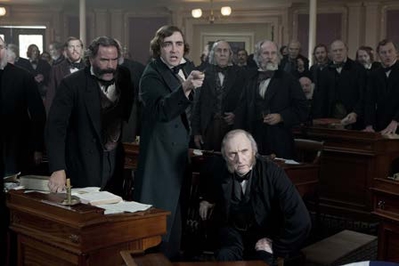 The filmmakers present this exchange in the most dramatic fashion possible, having Democratic leader Fernando Wood (D, NY) first disrupt the proceedings, allegedly waving “affidavits from loyal citizens” confirming the existence of secret peace talks. This creates chaos on the floor of the House that leads a fictional “conservative” Republican named Aaron Haddam to indicate (after receiving a critical nod from Preston Blair, perched in the gallery) that the “conservative faction of border and western Republicans” could not support an amendment “if a peace offer is being held hostage to its success.” Then there is a mad footrace from the Capitol to the White House, involving Lincoln’s aides and the Seward lobbyists. John Hay, the president’s young assistant private secretary, heatedly warns him against “making false representation” but Lincoln crafts his reply (technically true but obviously deceptive –since the commissioners were on their way to Hampton Roads, VA) and hands the note to seasoned lobbyist William N. Bilbo (James Spader). Bilbo then delivers it to Rep. Ashley who reads it with a flourish to the entire House. There is no record of any of this in the official proceedings. Nor does Ashley claim in his recollection that he read the note from the president on the House floor. Instead, it seems he may have simply showed it to some key figures. Bilbo was not even in Washington at the time (see previous post here). There was almost certainly no footrace. And no contemporary or historical account has Preston Blair in the gallery giving directions to conservative congressmen. Aaron Haddam is a fictional character, listed as a Republican from Kentucky, with no obvious historical counterpart. All of these details are included in the film for dramatic effect but without any real documentation –beyond the notes which Ashley claimed to have in his possession but which are not apparently available in their original forms, and his recollection of the episode, which most historians have accepted as credible.
The filmmakers present this exchange in the most dramatic fashion possible, having Democratic leader Fernando Wood (D, NY) first disrupt the proceedings, allegedly waving “affidavits from loyal citizens” confirming the existence of secret peace talks. This creates chaos on the floor of the House that leads a fictional “conservative” Republican named Aaron Haddam to indicate (after receiving a critical nod from Preston Blair, perched in the gallery) that the “conservative faction of border and western Republicans” could not support an amendment “if a peace offer is being held hostage to its success.” Then there is a mad footrace from the Capitol to the White House, involving Lincoln’s aides and the Seward lobbyists. John Hay, the president’s young assistant private secretary, heatedly warns him against “making false representation” but Lincoln crafts his reply (technically true but obviously deceptive –since the commissioners were on their way to Hampton Roads, VA) and hands the note to seasoned lobbyist William N. Bilbo (James Spader). Bilbo then delivers it to Rep. Ashley who reads it with a flourish to the entire House. There is no record of any of this in the official proceedings. Nor does Ashley claim in his recollection that he read the note from the president on the House floor. Instead, it seems he may have simply showed it to some key figures. Bilbo was not even in Washington at the time (see previous post here). There was almost certainly no footrace. And no contemporary or historical account has Preston Blair in the gallery giving directions to conservative congressmen. Aaron Haddam is a fictional character, listed as a Republican from Kentucky, with no obvious historical counterpart. All of these details are included in the film for dramatic effect but without any real documentation –beyond the notes which Ashley claimed to have in his possession but which are not apparently available in their original forms, and his recollection of the episode, which most historians have accepted as credible.
Then there is the matter of the roll call. It was an unusual affair. The House galleries were crowded, anticipation was high and the celebration afterward was unprecedented. Newspapers and magazines all took note of the revolutionary nature of the moment. Even the Congressional Globe invested this particular roll call with special drama, recording as it rarely did, outbursts of “considerable applause” when certain lame duck Democratic members, such as Rep. James English (D, CT), voted “ay” for the amendment. This has particular meaning in today’s context since there has erupted a small degree of controversy about Connecticut’s votes in 1865. In the “Lincoln” movie version of the roll call, two fictional congressmen from Connecticut cast the very first votes on the amendment –both nays. Yet in reality, the roll call proceeded in alphabetical order by congressman (not by state) and the entire four-man Connecticut delegation actually voted in favor of abolition (because of English’s critical switch). This second fact helped convince modern-day Connecticut congressman Joe Courtney (D, CT) to demand an apology from Steven Spielberg in early 2013 and to request a promise for a correction to the DVD edition of the movie. Scriptwriter Tony Kushner quickly dismissed the request and the affair struck many as a publicity stunt, but New York Times columnist Maureen Dowd then sided with the congressman with an op-ed provocatively headlined, “The Oscar for Best Fabrication.” What Dreamworks might do in the DVD that it promises to make freely available to every middle and high school in America remains to be seen.
Courtney was not the only figure upset by the filmmakers’ decisions regarding the roll call. The script altered dozens of names of representatives in the 38th Congress, some for obscure reasons. The filmed version of the final vote, for example, is full of fictitious names and invented dialogue. One of these characters –Walter H. Washburn of an unidentified state– casts a vote against the amendment. The problem is that there were two Washburns in the 38th Congress –a William Washburn and Elihu Washburne –both Republicans who voted eagerly in favor of the amendment. And naturally, their descendants are now disturbed by the implications of the movie and also want changes or corrections.
Most academic historians are less concerned about the name changes (although they seem strangely unnecessary) and have been more fixated on other minor differences from historical reality. There is the problem of the voting by state (which is a convention of political movies but not the historical Congress). Then the movie has figures in the gallery who were almost surely not there –such as Mary Lincoln and Preston Blair– but omits identifying figures we know to have been present, such as Frederick Douglass’s son, Charles, who wrote a touching letter afterward about the experience to his father. The film also attempts to enhance the suspense of the moment by cutting away to places such as Grant’s headquarters at City Point, Virginia, where there is depicted a telegraph reporting in real time about the voting –something that did not actually happen. And finally, there is the curious decision to have Thaddeus Stevens (Tommy Lee Jones) take the official copy of the amendment from Edward McPherson, the House clerk, claiming that he will “return it in the morning. Creased but unharmed.” One suspects that scriptwriter Tony Kushner must have some kind of source for that unique story –but if so, it is not yet apparent.
(This post has been excerpted from a longer essay, “Warning: Artists at Work,” that appears in “The Unofficial Guide to Spielberg’s Lincoln” which is part of the House Divided Project’s new Emancipation Digital Classroom).
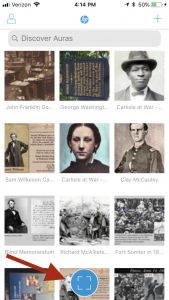


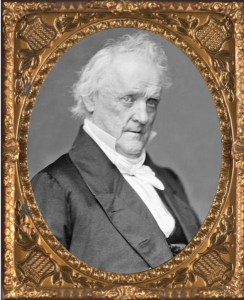

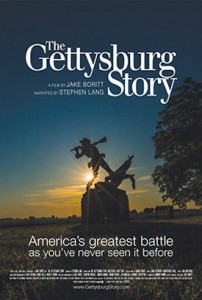
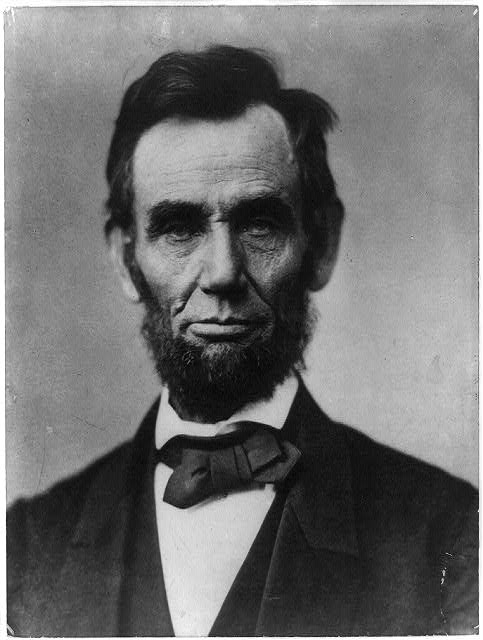
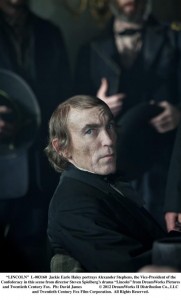 One of the several critical strands in the “Lincoln” movie concerns the controversy surrounding the Hampton Roads peace talks (February 3, 1865), where President Lincoln and Secretary of State Seward met with Confederate envoys Alexander Stephens, John Campbell and Robert M.T. Hunter for secret discussions about how to end the war on board the River Queen in Union-controlled Hampton Roads, Virginia (near Fortress Monroe). No transcript exists for their conversations that day. Lincoln and Seward died before leaving any recollection of the affair. So historians have mostly relied upon on the dubious
One of the several critical strands in the “Lincoln” movie concerns the controversy surrounding the Hampton Roads peace talks (February 3, 1865), where President Lincoln and Secretary of State Seward met with Confederate envoys Alexander Stephens, John Campbell and Robert M.T. Hunter for secret discussions about how to end the war on board the River Queen in Union-controlled Hampton Roads, Virginia (near Fortress Monroe). No transcript exists for their conversations that day. Lincoln and Seward died before leaving any recollection of the affair. So historians have mostly relied upon on the dubious  According to the “Lincoln” movie script, Friday, January 27, 1865 was an action-packed and pivotal day. It was the day of Thaddeus Stevens’s controlled performance in the House, declaring himself strictly for “equality before the law.” It was also the day marked by Abraham Lincoln’s bitter argument with his oldest son Robert and then his subsequent clash with his wife Mary after he finally decided to concede to Robert’s desire to join the Union army. And it was in the evening of the 27th that both Mary Lincoln and later dressmaker Elizabeth Keckley urged the president to abandon his hidden-hand approach and provide more decisive leadership in the fight for the antislavery amendment. All of those “events” are fictional, but they are essential for understanding the film’s point-of-view –namely, that Lincoln interjected himself at the end of the battle for the constitutional amendment in a way that proved decisive.
According to the “Lincoln” movie script, Friday, January 27, 1865 was an action-packed and pivotal day. It was the day of Thaddeus Stevens’s controlled performance in the House, declaring himself strictly for “equality before the law.” It was also the day marked by Abraham Lincoln’s bitter argument with his oldest son Robert and then his subsequent clash with his wife Mary after he finally decided to concede to Robert’s desire to join the Union army. And it was in the evening of the 27th that both Mary Lincoln and later dressmaker Elizabeth Keckley urged the president to abandon his hidden-hand approach and provide more decisive leadership in the fight for the antislavery amendment. All of those “events” are fictional, but they are essential for understanding the film’s point-of-view –namely, that Lincoln interjected himself at the end of the battle for the constitutional amendment in a way that proved decisive. The filmmakers present this exchange in the most dramatic fashion possible, having Democratic leader Fernando Wood (D, NY) first disrupt the proceedings, allegedly waving “affidavits from loyal citizens” confirming the existence of secret peace talks. This creates chaos on the floor of the House that leads a fictional “conservative” Republican named Aaron Haddam to indicate (after receiving a critical nod from Preston Blair, perched in the gallery) that the “conservative faction of border and western Republicans” could not support an amendment “if a peace offer is being held hostage to its success.” Then there is a mad footrace from the Capitol to the White House, involving Lincoln’s aides and the Seward lobbyists. John Hay, the president’s young assistant private secretary, heatedly warns him against “making false representation” but Lincoln crafts his reply (technically true but obviously deceptive –since the commissioners were on their way to Hampton Roads, VA) and hands the note to seasoned lobbyist William N. Bilbo (James Spader). Bilbo then delivers it to Rep. Ashley who reads it with a flourish to the entire House. There is no record of any of this in the official proceedings. Nor does Ashley claim in his recollection that he read the note from the president on the House floor. Instead, it seems he may have simply showed it to some key figures. Bilbo was not even in Washington at the time (see previous post
The filmmakers present this exchange in the most dramatic fashion possible, having Democratic leader Fernando Wood (D, NY) first disrupt the proceedings, allegedly waving “affidavits from loyal citizens” confirming the existence of secret peace talks. This creates chaos on the floor of the House that leads a fictional “conservative” Republican named Aaron Haddam to indicate (after receiving a critical nod from Preston Blair, perched in the gallery) that the “conservative faction of border and western Republicans” could not support an amendment “if a peace offer is being held hostage to its success.” Then there is a mad footrace from the Capitol to the White House, involving Lincoln’s aides and the Seward lobbyists. John Hay, the president’s young assistant private secretary, heatedly warns him against “making false representation” but Lincoln crafts his reply (technically true but obviously deceptive –since the commissioners were on their way to Hampton Roads, VA) and hands the note to seasoned lobbyist William N. Bilbo (James Spader). Bilbo then delivers it to Rep. Ashley who reads it with a flourish to the entire House. There is no record of any of this in the official proceedings. Nor does Ashley claim in his recollection that he read the note from the president on the House floor. Instead, it seems he may have simply showed it to some key figures. Bilbo was not even in Washington at the time (see previous post 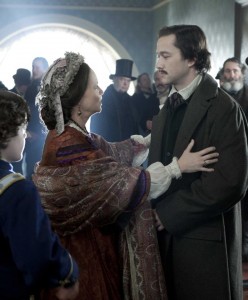 No single film could ever hope to capture the range of historical interpretations that have been offered to explain the complicated Lincoln family dynamics. Some historians consider the marriage between Abraham and Mary Lincoln to have been “a fountain of misery.” Others see longstanding affection and partnership. Some find Lincoln to have been essentially an absentee father. Others extol his sensitive parenting toward very different sons. And these debates have proven especially difficult to resolve because the evidence is so thin. Hardly any of the family correspondence remains. None of the family members kept diaries. Almost all of our information about their relationship derives from second- or third-hand accounts, usually recollected after the war.
No single film could ever hope to capture the range of historical interpretations that have been offered to explain the complicated Lincoln family dynamics. Some historians consider the marriage between Abraham and Mary Lincoln to have been “a fountain of misery.” Others see longstanding affection and partnership. Some find Lincoln to have been essentially an absentee father. Others extol his sensitive parenting toward very different sons. And these debates have proven especially difficult to resolve because the evidence is so thin. Hardly any of the family correspondence remains. None of the family members kept diaries. Almost all of our information about their relationship derives from second- or third-hand accounts, usually recollected after the war. Nor is there any basis in the historical record for intertwining the story of Robert Lincoln’s late entry into the Union army with his father’s increasingly determined efforts to secure passage of the antislavery amendment. Yet in one of the movie’s more audacious –and improbable– plot twists, scriptwriter Tony Kushner follows the explosive back-to-back family arguments of Scenes 29 and 30 with a revealing trip to the opera that suddenly provides a personal motivation for Lincoln’s new sense of urgency about the amendment’s passage. The script identifies the opera as Gounod’s “Faust” at the Odd Fellows Hall with the president, his wife and Elizabeth Keckley in attendance. In reality, the Lincolns had seen this popular opera with William Seward when it was showing at Grover’s Theater during the previous month, in
Nor is there any basis in the historical record for intertwining the story of Robert Lincoln’s late entry into the Union army with his father’s increasingly determined efforts to secure passage of the antislavery amendment. Yet in one of the movie’s more audacious –and improbable– plot twists, scriptwriter Tony Kushner follows the explosive back-to-back family arguments of Scenes 29 and 30 with a revealing trip to the opera that suddenly provides a personal motivation for Lincoln’s new sense of urgency about the amendment’s passage. The script identifies the opera as Gounod’s “Faust” at the Odd Fellows Hall with the president, his wife and Elizabeth Keckley in attendance. In reality, the Lincolns had seen this popular opera with William Seward when it was showing at Grover’s Theater during the previous month, in 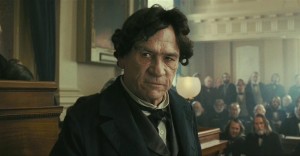 In the scene in Spielberg’s “Lincoln” which introduces the audience to Rep.
In the scene in Spielberg’s “Lincoln” which introduces the audience to Rep. 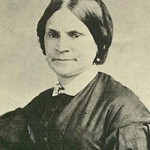 Smith
Smith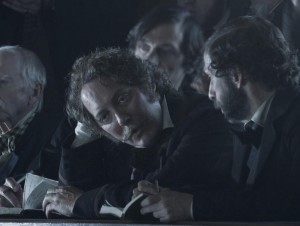 Although “Lincoln” is a serious movie with a high moral purpose, there is still a great deal of comic relief provided mostly by an amusing trio of corrupt lobbyists. What students might find confusing about these figures, however, is that despite the fact that they were “real” men, the movie either totally invents or sometimes just thoroughly rearranges their actual activities.
Although “Lincoln” is a serious movie with a high moral purpose, there is still a great deal of comic relief provided mostly by an amusing trio of corrupt lobbyists. What students might find confusing about these figures, however, is that despite the fact that they were “real” men, the movie either totally invents or sometimes just thoroughly rearranges their actual activities. 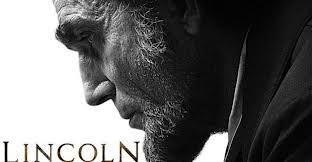 The main narrative of Steven Spielberg’s “Lincoln” movie opens with a dream that
The main narrative of Steven Spielberg’s “Lincoln” movie opens with a dream that  Consider this incongruity: in the movie, Seward (David Strathairn) asks Lincoln, “since when has our party unanimously supported anything?” and yet the correct historical answer to that question is simply the last time the abolition amendment appeared in the House (June 1864) when the ONLY Republican to vote against it was Rep. James Ashley, the sponsor, who did so on technical grounds so that he could bring it back later for reconsideration. By the end of the war, Republicans supported the abolition of slavery –it was a central plank of their party platform in the 1864 election and part of the basis for their landslide victories in November. Border states such as Maryland and Missouri were already in the process of abolishing slavery on their own –with full Republican support. Montgomery Blair had been “pushed out” of the president’s cabinet in September 1864 as part of a deal with radicals –as the movie suggests– but Preston Blair (Hal Holbrook) surely never told Lincoln, as he does in the film: “We can’t tell our people they can vote yes on abolishing slavery unless at the same time we can tell ‘em that you’re seeking a negotiated peace.” It’s not even entirely clear that the elderly and highly controversial Blair had any “people” left in the House now that his other son Frank (Francis Preston Blair, Jr.), a former congressman, was back in the Union army.
Consider this incongruity: in the movie, Seward (David Strathairn) asks Lincoln, “since when has our party unanimously supported anything?” and yet the correct historical answer to that question is simply the last time the abolition amendment appeared in the House (June 1864) when the ONLY Republican to vote against it was Rep. James Ashley, the sponsor, who did so on technical grounds so that he could bring it back later for reconsideration. By the end of the war, Republicans supported the abolition of slavery –it was a central plank of their party platform in the 1864 election and part of the basis for their landslide victories in November. Border states such as Maryland and Missouri were already in the process of abolishing slavery on their own –with full Republican support. Montgomery Blair had been “pushed out” of the president’s cabinet in September 1864 as part of a deal with radicals –as the movie suggests– but Preston Blair (Hal Holbrook) surely never told Lincoln, as he does in the film: “We can’t tell our people they can vote yes on abolishing slavery unless at the same time we can tell ‘em that you’re seeking a negotiated peace.” It’s not even entirely clear that the elderly and highly controversial Blair had any “people” left in the House now that his other son Frank (Francis Preston Blair, Jr.), a former congressman, was back in the Union army.